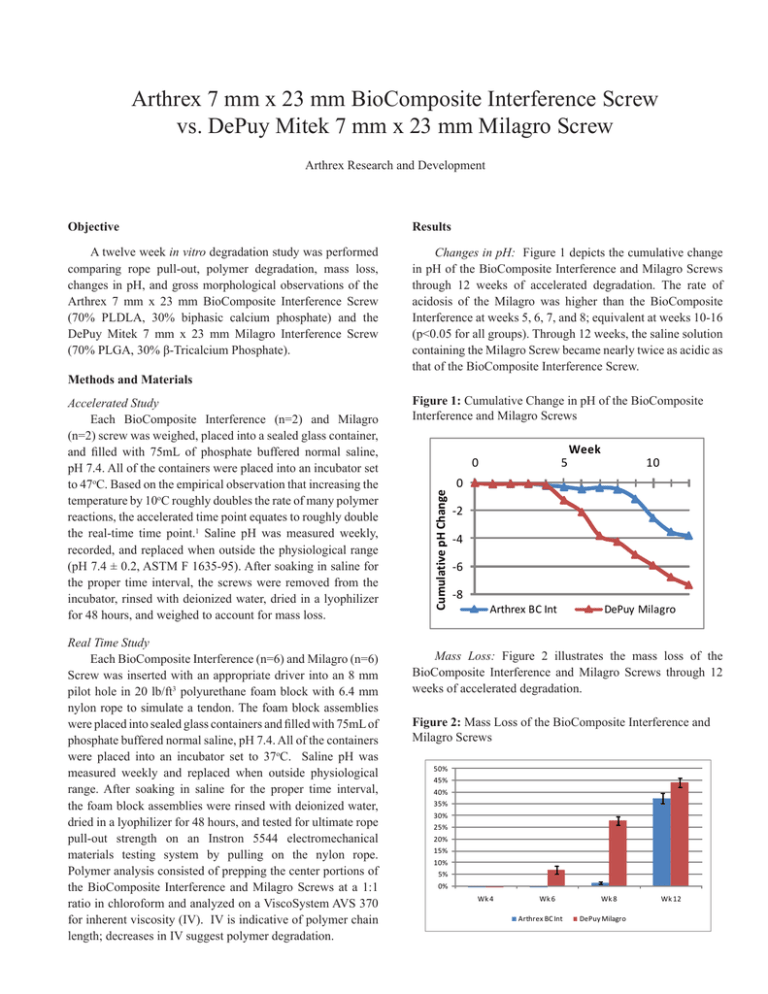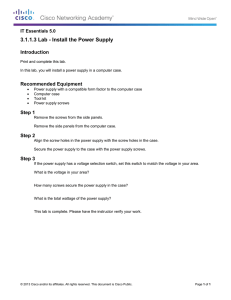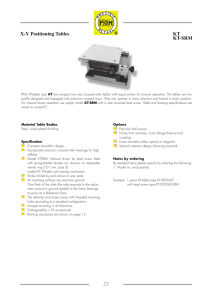
Arthrex 7 mm x 23 mm BioComposite Interference Screw
vs. DePuy Mitek 7 mm x 23 mm Milagro Screw
Arthrex Research and Development
Objective
Results
A twelve week in vitro degradation study was performed
comparing rope pull-out, polymer degradation, mass loss,
changes in pH, and gross morphological observations of the
Arthrex 7 mm x 23 mm BioComposite Interference Screw
(70% PLDLA, 30% biphasic calcium phosphate) and the
DePuy Mitek 7 mm x 23 mm Milagro Interference Screw
(70% PLGA, 30% β-Tricalcium Phosphate).
Changes in pH: Figure 1 depicts the cumulative change
in pH of the BioComposite Interference and Milagro Screws
through 12 weeks of accelerated degradation. The rate of
acidosis of the Milagro was higher than the BioComposite
Interference at weeks 5, 6, 7, and 8; equivalent at weeks 10-16
(p<0.05 for all groups). Through 12 weeks, the saline solution
containing the Milagro Screw became nearly twice as acidic as
that of the BioComposite Interference Screw.
Methods and Materials
Real Time Study
Each BioComposite Interference (n=6) and Milagro (n=6)
Screw was inserted with an appropriate driver into an 8 mm
pilot hole in 20 lb/ft3 polyurethane foam block with 6.4 mm
nylon rope to simulate a tendon. The foam block assemblies
were placed into sealed glass containers and filled with 75mL of
phosphate buffered normal saline, pH 7.4. All of the containers
were placed into an incubator set to 37oC. Saline pH was
measured weekly and replaced when outside physiological
range. After soaking in saline for the proper time interval,
the foam block assemblies were rinsed with deionized water,
dried in a lyophilizer for 48 hours, and tested for ultimate rope
pull-out strength on an Instron 5544 electromechanical
materials testing system by pulling on the nylon rope.
Polymer analysis consisted of prepping the center portions of
the BioComposite Interference and Milagro Screws at a 1:1
ratio in chloroform and analyzed on a ViscoSystem AVS 370
for inherent viscosity (IV). IV is indicative of polymer chain
length; decreases in IV suggest polymer degradation.
Figure 1: Cumulative Change in pH of the BioComposite
Interference and Milagro Screws
Week
0
Cumulative pH Change
Accelerated Study
Each BioComposite Interference (n=2) and Milagro
(n=2) screw was weighed, placed into a sealed glass container,
and filled with 75mL of phosphate buffered normal saline,
pH 7.4. All of the containers were placed into an incubator set
to 47oC. Based on the empirical observation that increasing the
temperature by 10oC roughly doubles the rate of many polymer
reactions, the accelerated time point equates to roughly double
the real-time time point.1 Saline pH was measured weekly,
recorded, and replaced when outside the physiological range
(pH 7.4 ± 0.2, ASTM F 1635-95). After soaking in saline for
the proper time interval, the screws were removed from the
incubator, rinsed with deionized water, dried in a lyophilizer
for 48 hours, and weighed to account for mass loss.
5
10
0
-2
-4
-6
-8
Arthrex BC Int
DePuy Milagro
Mass Loss: Figure 2 illustrates the mass loss of the
BioComposite Interference and Milagro Screws through 12
weeks of accelerated degradation.
Figure 2: Mass Loss of the BioComposite Interference and
Milagro Screws
50%
45%
40%
35%
30%
25%
20%
15%
10%
5%
0%
Wk 4
Wk 6
Arthrex BC Int
Wk 8
DePuy Milagro
Wk 12
Gross Morphological Observations: Table 1 depicts the
BioComposite Interference and Milagro Screws through 12
weeks of accelerated degradation. Representative screws at
dynamic time points for both groups are shown. By week 8, one
Milagro screw had cracked. By week 12, both Milagro screws
had cracked. Through 12 weeks of accelerated degradation,
the BioComposite Interference screws remained intact.
Table 1: Gross Morphological Observations of the
BioComposite Interference and Milagro Screws
BioComposite
Interference
Milagro
Wk 0
Wk 8
Conclusion
Composite screws should be optimized for mechanical
strength and material behavior while being benign. Polymer
degradation that occurs too quickly may decrease the local pH
at the surgical repair site, thereby increasing the activity of
osteoclasts to resorb tissue and screw material, weakening the
interface, and inducing inflammation.2,3 Healing at the surgical
site begins quite rapidly: After surgery, weeks 8 through 12 are
associated with key healing pathways in the development of
soft tissue, including the maturation of collagen and improved
cellular organization.4,5,6
The rate of polymer degradation associated with the
Milagro screw accounts for the high level of acidosis observed
in the accelerated study. A significant portion of the Milagro’s
acidosis occurs during the equivalent of weeks 8 through 12 realtime, and may delay healing as well as inducing inflammation
at the surgical site. The BioComposite Interference Screw
begins acidosis during the equivalent of weeks 16 through 20
real-time, after a significant portion of tissue regeneration has
occurred. It has been shown that the composite material used
in the BioComposite Interference Screw acts as a pH buffer,
reducing the concern that any adverse reaction, associated
with local acidosis, may occur.7
Wk 12
References
Rope Pull-out: Through 12 weeks of real-time degradation,
there was not a significant change in rope pull-out strength
of the BioComposite Interference or Milagro Screws when
compared to time zero (p= 0.714 and p=0.838, respectively).
Polymer Analysis: Table 2 depicts the inherent viscosity of
the BioComposite Interference and Milagro Screws through 12
weeks of real-time degradation. The 10% decrease in IV of the
BioComposite Inteference Screw is significant (p=0.036). The
53% decrease in IV of the Milagro is significant (p<0.001).
1. Hemmerich, Karl J., General Aging Theory and Simplified
Protocol for Accelerated Aging of Medical Devices, Med. Plastics
and Biomaterials, July 1998.
2. Komarova et al, Proc Natl Acad Sci USA, 102:2643-2648, 2005.
3. Hunt et al, Knee Surg Sports Traumatol Arthrosc, 6:655-660, 2008.
4. Bos et al, Biomaterials, 1:32-36, 1991.
5. Gutwald et al, J Mater Sci Mater Med, 5: 481-490, 1994.
6. Pierre et al, J Shoulder Elbow Surg, 5:58, 1996.
7. Agrawal et al, J Biomed Mater Res, 38:105-114.
Table 2: Polymer Analysis of the BioComposite Interference
and Milagro Screws
Inherent
Viscosity (dl/g)
BioComposite
Interference Screw
Milagro Screw
Wk 0
2.16 ± 0.07
1.34 ± 0.02
Wk 12
1.95 ± 0.15
0.63 ± 0.12
% Decrease
10%
53%
© 2009 Arthrex Inc. All rights reserved. LA0153A



